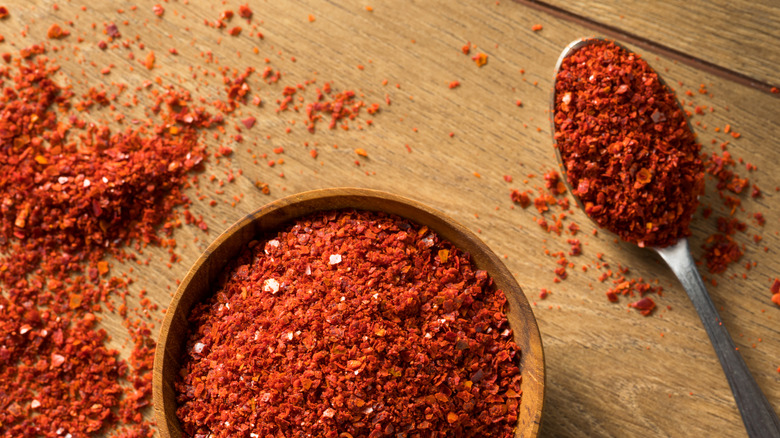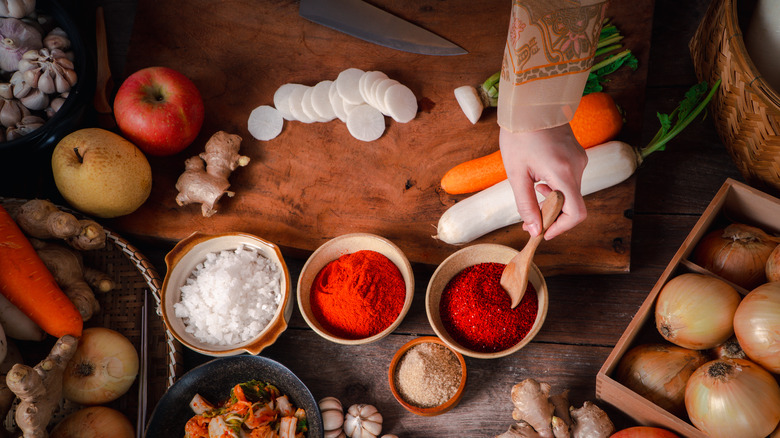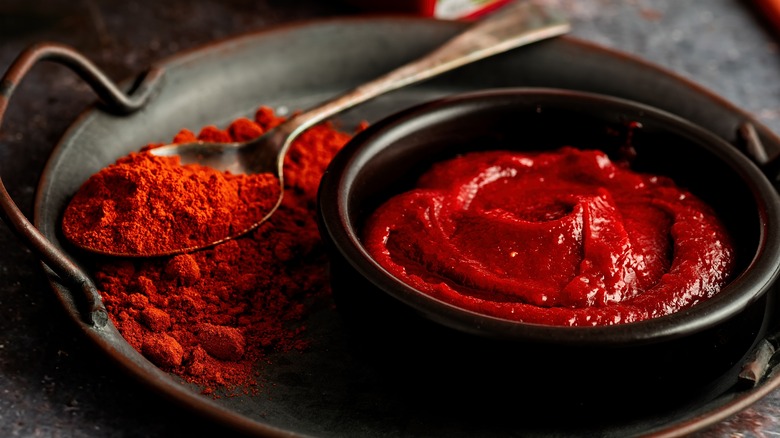What Is Gochugaru (And How Is It Different From Gochujang)?
Wandering through the spice aisle can often be an intimidating experience, and one shelf, in particular, might just leave you scratching your head. Navigating the difference between cayenne powder, chili powder, and red pepper flakes can be difficult, especially when they all kind of sound like different names for the exact same thing.
Among these many variations on a theme, there is one that shouldn't be skipped over, and that is gochujang. Gochujang is a red chili powder that hails from South Korea. It's made from the taeyangcho pepper, and is a common item in many of the country's most popular dishes. It's used as a part of the signature kimchi spice mix, serves as the heat in the chili pepper paste gochujang, and is often added to Korean barbecue, soups, stews, and countless other dishes.
One of the most unique qualities of gochugaru is that it adds more to a dish than just heat. Other peppers might only burn your mouth without adding much flavor, but gochugaru is well regarded for its fruity, smoky flavor and subtle heat. While some different styles of gochugaru are spicier than others, they're still only about one-third of the heat measured in most cayenne powders. That means that you can enjoy some extra spice and flavor, but you won't be sweating your way through your entire meal.
History of gochugaru
Chile peppers are famously native to the Central and Southern Americas, but there is some debate as to how they first arrived on the Korean peninsula. While there's no documented evidence of chili peppers existing in Korea until the 16th century, there is also a competing theory that argues that the peppers have existed there much, much longer.
A published study conducted by The Korea Food Research Institute and The Academy of Korean Studies suggests that the first pepper seeds were brought to the peninsula by birds millions of years ago. This is supported by the fact that Koreans have been making kimchi with gochugaru for thousands of years, and some older documents may even reference Korean chile peppers.
Botanist, historian, and food writer Heather Arndt Anderson says that one of the chile pepper's actual evolutionary advantages is that avian species don't taste the heat of the capsaicin. This means that landbound mammals typically avoid the plant, but birds are free to spread the seeds for miles.
Regardless of where the pepper originated though, it has served as a common ingredient in Korean homes for a very long time. While there are many varieties available in Korean grocery stores, many people also like to make their own at home, since the process of drying and grinding the peppers is fairly simple.
The difference between gochugaru and gochujang
While gochugaru is used in gochujang, the two condiments have different tastes and consistencies. This means that while the two can be swapped out in some circumstances, it's not an ideal exchange, and such action is best saved for when you're in a bind.
Gochujang is made into a paste with fermented soybeans, glutinous rice flour, malted barley, and salt, in addition to gochugaru. It also typically undergoes a fermentation period where the paste is left to rest in earthenware jars. This gives it a signature savory umami-ness. Since it is also made from fermented grains and legumes, it is actually quite similar to Japanese miso paste. Miso obtains the same savory qualities through its own aging process.
While gochujang may have the heat of the gochugaru, using chili powder in place of the paste in a recipe will subtract some of its more complex notes. It's best to use gochugaru as you would any other chili powder, and use it to add a hint of spice to items like salads, stews, and marinades.


